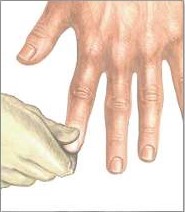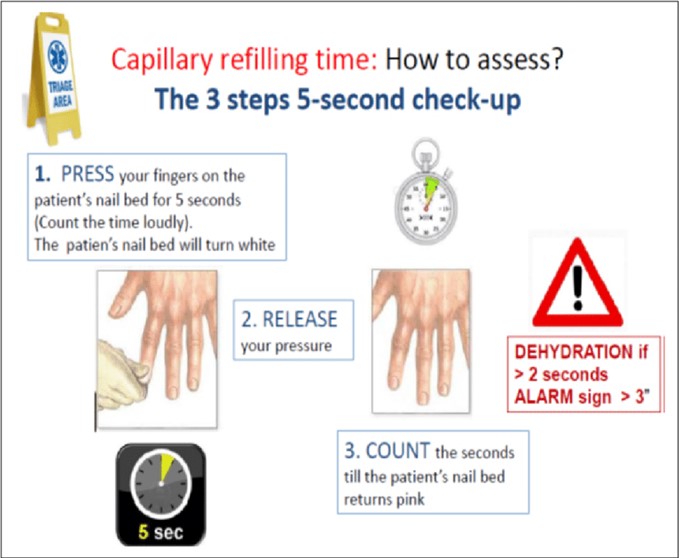The practical nurse (PN) applies and then releases pressure to a client's fingernail as seen in the photo. Normal nail color returns in 2 seconds. Which action should the PN take?

Report abnormal findings to the charge nurse.
Observe for blanching of the nailbed.
Repeat the process with a different nailbed.
Document the capillary refill time.
The Correct Answer is D
- Capillary refill time is a test that measures how quickly the blood returns to the tissues after pressure is applied and released on a nailbed or a fingertip. It is an indicator of peripheral circulation and tissue perfusion.
- To perform the capillary refill test, the examiner should press firmly on the nailbed or fingertip for a few seconds, then release the pressure and observe how long it takes for the normal color to return. The normal capillary refill time is less than 2 seconds .
- In the photo, the practical nurse (PN) applies and then releases pressure to a client's fingernail. Normal nail color returns in 2 seconds, which indicates a normal capillary refill time and adequate peripheral circulation. This is a normal and expected finding that does not require any further action, except for documentation.
- Therefore, option D is the correct answer, as it reflects the appropriate and standard nursing practice of documenting any assessment findings in the client's chart. Option D also implies that the PN does not need to report, observe, or repeat anything else related to the capillary refill test, as it was done correctly and yielded normal results.
- Options A, B, and C are incorrect answers, as they do not reflect the appropriate or necessary actions for the PN to take after performing a normal capillary refill test.

Nursing Test Bank
Naxlex Comprehensive Predictor Exams
Related Questions
Correct Answer is D, C, A, B
Explanation
- A 12-year-old child with a history of asthma is wheezing and complaining of shortness of breath. Wheezing and shortness of breath indicate respiratory distress, which can be a medical emergency for a child with asthma. Prompt intervention and assessment of the child's respiratory status are crucial.
- A 7-year-old child who has type 1 diabetes mellitus is experiencing extreme hunger and shakiness. These symptoms may indicate hypoglycemia, which requires immediate attention to prevent further complications. The PN should assess the child's blood glucose levels and provide appropriate treatment.
- A 10-year-old child with bleeding lacerations on both knees after falling on the playground. While bleeding lacerations require attention, they are not immediately life-threatening or likely to cause severe complications. However, the PN should still address this child's injuries promptly and provide appropriate wound care.
- A 5-year-old child is crying uncontrollably because of an incontinent bowel episode. While the child's distress is significant, it does not indicate an immediate life-threatening condition or urgent medical need. The PN should provide comfort, and reassurance, and assist with appropriate hygiene measures for the child.
Prioritizing care in this order ensures that the most urgent and potentially life-threatening conditions are addressed first, followed by those requiring immediate attention but with a lower risk of complications. Finally, the PN can attend to the client with a condition that, while distressing, is not immediately life-threatening or urgent.
Correct Answer is A
Explanation
A. Checking the child’s blood glucose level via fingerstick is the most important step before administering insulin to prevent hypoglycemia or ensure the appropriate dose.
B. Exercise affects blood sugar, but the immediate priority is verifying the blood glucose level.
C. Urination patterns can indicate hyperglycemia, but they are not the most critical factor before insulin administration.
D. Eating is important, but insulin dosing should be based on blood glucose readings and meal intake combined.
Whether you are a student looking to ace your exams or a practicing nurse seeking to enhance your expertise , our nursing education contents will empower you with the confidence and competence to make a difference in the lives of patients and become a respected leader in the healthcare field.
Visit Naxlex, invest in your future and unlock endless possibilities with our unparalleled nursing education contents today
Report Wrong Answer on the Current Question
Do you disagree with the answer? If yes, what is your expected answer? Explain.
Kindly be descriptive with the issue you are facing.
